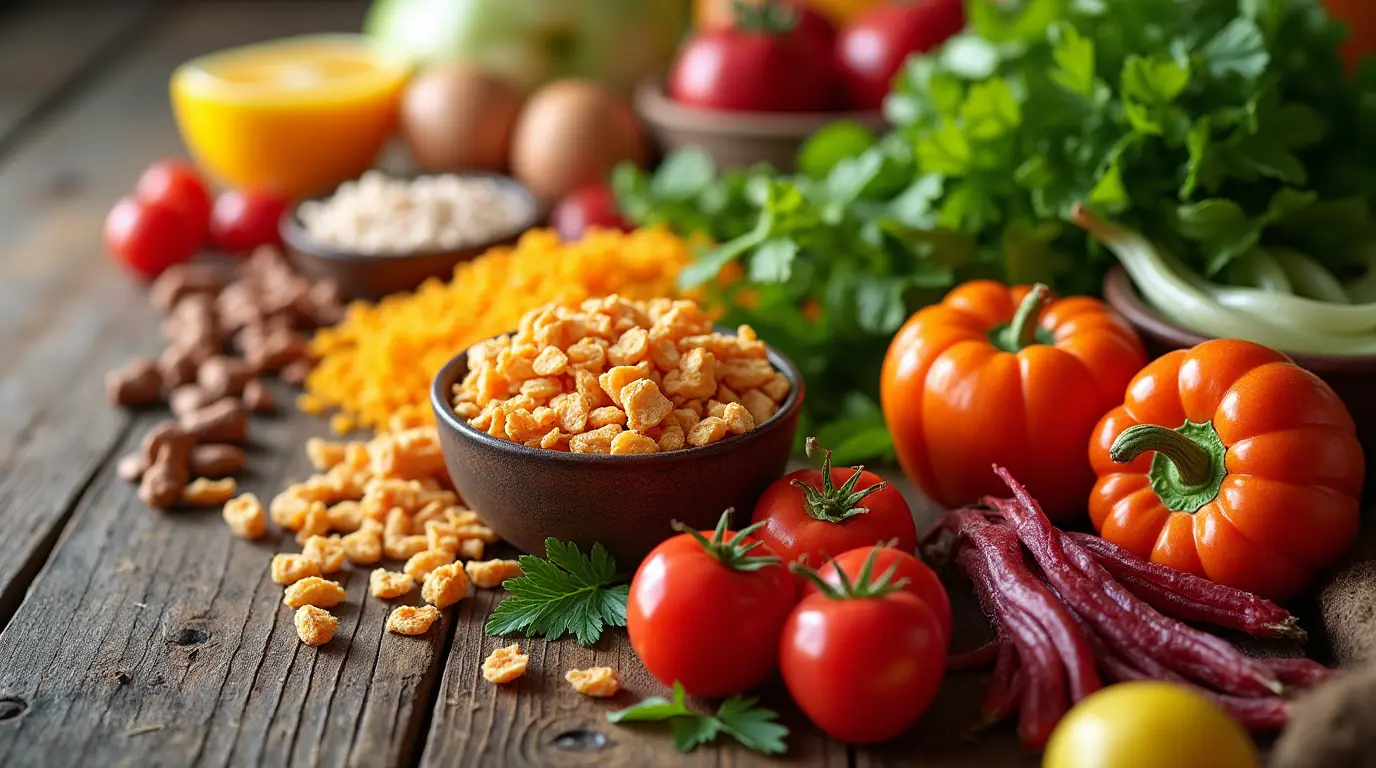Ever heard of shribried foods and wondered what they are?
This lesser-known food category is gaining traction for being light, nutrient-rich, and surprisingly versatile. From breakfasts to dinners, shribried foods are transforming how health-conscious cooks approach everyday meals, without sacrificing flavor. Here’s how to bring them to your table.
Table of Contents
What Are Shribried Foods?
Shribried foods, a term blending “shrivel” and “dried,” are lightweight food items made through advanced dehydration techniques. By removing almost all water content, these foods become compact, easy to store, and quick to rehydrate. Examples include freeze-dried fruits, instant soups, and powdered milk. This process preserves flavor and nutrients, making these foods a top choice for convenient meals and snacks.
History and Origin of Shribried Foods
The concept of dehydration as a preservation method isn’t new. Ancient civilizations like the Egyptians and Romans dried fruits and meats to extend shelf life. However, modern shribried food production began in the 20th century, coinciding with technological advancements like freeze-drying and vacuum-sealing. Initially used for military rations and space missions, these foods have since become a pantry staple for many households.
Nutritional Value and Popularity Trends
One of the standout features of shribried foods is their high nutritional retention compared to traditional preservation methods. Thanks to minimal processing, they maintain essential vitamins, minerals, and flavors. This makes them an appealing choice for health-conscious consumers. Over the years, shribried foods have gained traction not only among outdoor enthusiasts but also among those seeking sustainable and convenient meal options.
With their versatility and efficiency, shribried foods continue to be a marvel of modern food science. Their journey from ancient drying techniques to high-tech production sets the stage for exploring their types, benefits, and future potential.
Types of Shribried Foods and Their Uses
Common Categories of Shribried Foods
Shribried foods come in a variety of forms, catering to diverse needs. Popular categories include freeze-dried fruits like strawberries and mangoes, dehydrated vegetables such as peas and carrots, and instant meals like noodles or soups. Additionally, powdered products like milk or protein powders are widely recognized for their convenience. These foods have a broad appeal because they retain the natural flavors and nutrients of their fresh counterparts while offering unmatched longevity.
Cooking and Culinary Applications

In the kitchen, shribried foods are incredibly versatile. They can be rehydrated and used in traditional recipes or enjoyed as-is for quick snacks. For instance, freeze-dried fruits can be added to smoothies, cereals, or baked goods, while dehydrated vegetables work well in soups, stews, or casseroles. These foods are especially popular among campers and hikers who need lightweight, energy-packed meals that are easy to prepare in remote locations.
Regional Variations in Shribried Foods
Different cultures have developed their own shribried food specialties. In Asia, dried noodles and instant ramen dominate the market. Meanwhile, Western countries favor freeze-dried fruits and ready-to-eat meals for outdoor adventures. Latin America boasts unique offerings like dried beans and powdered drink mixes. These regional preferences showcase how shribried foods are tailored to meet local tastes and needs.
Looking to learn how dried foods are incorporated into high-protein diets? Check out high-protein desserts for ideas on adding variety to your meals.
Benefits of Shribried Foods
Nutritional Advantages
One of the most compelling reasons to embrace shribried foods is their impressive nutritional profile. Unlike traditional preservation methods that may strip away nutrients, these foods retain a majority of their original vitamins and minerals. This makes them an excellent choice for maintaining a balanced diet, especially for individuals on the go or those with limited access to fresh produce.
Long Shelf Life and Convenience
Shribried foods are synonymous with longevity and ease. Their extended shelf life ensures that they remain usable for months or even years when stored properly. This is a boon for anyone stocking up for emergencies or looking to minimize food waste. Moreover, their lightweight and compact nature make them a favorite among backpackers, who value every ounce of saved weight during their travels.
Sustainability and Reduced Food Waste
Embracing shribried foods can also contribute to a more sustainable lifestyle. By reducing spoilage and extending usability, these foods help minimize waste. Additionally, the production process often requires fewer resources compared to fresh food transportation and storage, making them a greener alternative.
Challenges and Concerns with Shribried Foods
Health Implications of Overconsumption
While shribried foods are a fantastic option for many situations, relying too heavily on them can have downsides. Some products are high in sodium or added preservatives to enhance flavor and shelf life. For individuals with specific dietary restrictions, such as low-sodium or heart-friendly diets, this could pose a concern. Moderation is key to ensuring these foods support overall well-being rather than detract from it.
Environmental Impact of Production
Producing shribried foods often involves energy-intensive processes like freeze-drying and vacuum sealing. These methods, while effective, can contribute to carbon emissions. Additionally, single-use packaging materials, which are common in this industry, add to environmental waste. Seeking out brands that prioritize sustainable practices or offer biodegradable packaging can help reduce the environmental footprint.
Quality and Flavor Concerns
Another common concern with shribried foods is the potential loss of flavor or texture. Though the dehydration process preserves nutrients, the final product might not taste as rich as its fresh counterpart. Rehydration can sometimes leave ingredients feeling rubbery or bland, depending on the product quality. Consumers can avoid this issue by choosing high-quality brands known for maintaining flavor integrity.
For recipes that emphasize fresh ingredients while incorporating stored items, explore potluck main dish recipes for balance and inspiration.
Tips for Choosing and Using Shribried Foods
How to Identify High-Quality Shribried Products
To make the most of shribried foods, focus on product labels. Look for options with minimal additives and preservatives. Organic or non-GMO certifications are also signs of higher quality. Additionally, pay attention to the nutritional information, ensuring the product aligns with your dietary needs and goals.
Storage and Preparation Guidelines
Proper storage is crucial for extending the shelf life of shribried foods. Keep them in a cool, dry place, away from direct sunlight and moisture. When preparing these foods, follow the manufacturer’s rehydration instructions closely to achieve the best taste and texture. Using filtered water for rehydration can also enhance the flavor.
Incorporating Shribried Foods into a Balanced Diet
These foods shine when integrated into a balanced diet. Combine shribried fruits with fresh yogurt for a quick breakfast or use dehydrated vegetables to add nutrients to soups. By pairing them with fresh ingredients, you can enjoy the best of both worlds.
For more insight into innovative meal ideas, explore healthy baking recipes that incorporate shribried ingredients seamlessly.
Frequently Asked Questions (FAQs)
What foods are stilbenoid?
Stilbenoids are a type of natural plant compound known for their antioxidant and anti-inflammatory properties. The most well-known stilbenoid is resveratrol.
Foods rich in stilbenoids include:
Red grapes (especially the skin)
Blueberries
Mulberries
Cranberries
Peanuts
Pistachios
Red wine (due to grape skins)
These foods are often associated with cardiovascular and longevity benefits thanks to the presence of resveratrol, a key stilbenoid.
Let me know if you want a full chart or recipe ideas using stilbenoid-rich foods.
What are good shareable foods?
Here are some great shareable foods – perfect for potlucks, gatherings, or casual dinners:
🍽️ Savory Shareables
Sliders (mini burgers or pulled beef/chicken)
Loaded nachos with cheese, beef, beans, and toppings
Wings (buffalo, BBQ, or garlic parmesan)
Quesadillas (cut into wedges)
Meatballs with toothpicks (BBQ or teriyaki style)
Flatbreads or pizzas (cut into squares)
Deviled eggs
Stuffed mushrooms
🥗 Lighter Options
Charcuterie boards (cheese, meats, crackers, fruit)
Caprese skewers (mozzarella, tomato, and olives)
Mini lettuce wraps with chicken or beef
Dips with chips (guacamole, hummus, spinach-artichoke)
🍰 Sweet Shareables
Brownie bites
Mini cheesecakes
Fruit skewers with yogurt dip
Cookies (especially assorted or sandwich-style)
Puff pastry pinwheels
Want ideas specifically for potlucks, family-style dinners, or game nights?
What foods have the most strontium in them?
Foods naturally rich in strontium a trace mineral that supports bone health include:
🥬 High-Strontium Foods:
Leafy green vegetables
Kale
Spinach
Collard greens
Root vegetables
Beets
Turnips
Carrots
Seafood
Shellfish (especially shrimp and scallops)
Fish (especially those with bones like sardines)
Legumes
Beans
Lentils
Whole grains
Brown rice
Oats
Barley
Dairy products (small amounts)
Cheese
Milk
While food contains only small amounts of strontium, it’s considered safe and beneficial in natural dietary sources. Supplements (like strontium ranelate) offer higher doses, but should be used with medical guidance
What are some microbiome foods list?
Here’s a powerful list of microbiome-friendly foods that help nourish and diversify your gut bacteria essential for digestion, immunity, and overall health:
🧬 Top Microbiome-Boosting Foods
1. Fermented Foods (rich in probiotics)
Yogurt (with live cultures)
Kefir
Sauerkraut
Kimchi
Miso
Tempeh
Pickles (naturally fermented)
Kombucha
2. Prebiotic-Rich Foods (feed your good bacteria)
Garlic
Onions
Leeks
Asparagus
Jerusalem artichokes
Bananas (slightly green)
Apples
Chicory root
3. High-Fiber Plant Foods
Lentils
Chickpeas
Oats
Barley
Flaxseeds
Chia seeds
Sweet potatoes
Broccoli
4. Polyphenol-Rich Foods (protect and feed your gut microbes)
Berries (blueberries, raspberries)
Green tea
Dark chocolate (70%+)
Red grapes
Extra virgin olive oil
🧠 Pro Tip: A diverse diet = a diverse microbiome.
The more variety of whole plant foods you eat each week, the healthier your gut ecosystem becomes.

